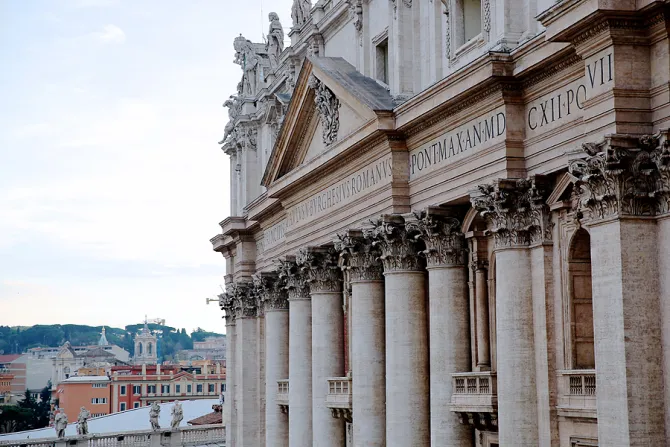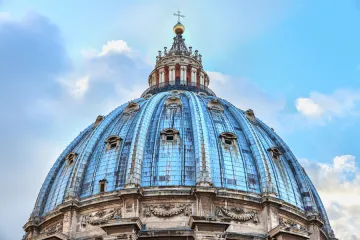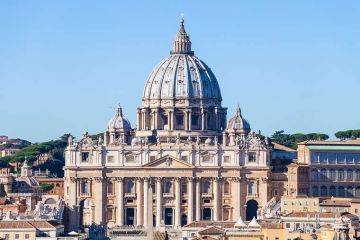Vatican City, Jun 22, 2021 / 12:00 pm
The cardinal in charge of St. Peter’s Basilica has clarified details of a ban on the celebration of private Masses in the upper part of the basilica.
Cardinal Mauro Gambetti, the new archpriest of the basilica, said June 22 that requests to celebrate, instead of concelebrate, early morning Masses at St. Peter’s by groups “with particular and legitimate needs” may be allowed.
In March, the Secretariat of State posted a communication in the sacristy of St. Peter’s Basilica restricting the celebration of individual Masses at the basilica’s many side altars.
The communication said that the reason for the change, which went into effect March 22, was to ensure that “the Holy Masses in St. Peter’s Basilica take place in a climate of recollection and liturgical decency.”
The document restricting private Masses in St. Peter’s Basilica garnered attention not only for its content, but also for its unusual format and release.
The letter was not accompanied by any official Vatican communication and there was no signature except the initials of Archbishop Edgar Peña Parra, who heads the First Section of the Secretariat of State, which is not typically responsible for liturgical celebrations.
The document was also not addressed to Cardinal Gambetti -- though he had been appointed archpriest of St. Peter’s Basilica in February -- but to Archbishop Mario Giordana, extraordinary commissioner of the Fabric of St. Peter. This was unusual, since the Fabric of St. Peter does not deal with liturgical celebrations in the basilica.
The new protocols were criticized by Cardinals Joseph Zen, Robert Sarah, Raymond Burke, Gerhard Müller, and Walter Brandmüller.
Previously, the 45 altars and 11 chapels in the upper part of the Vatican basilica were used for the celebration of daily Masses from 7 a.m. to 9 a.m. Some of the priests who offered Mass did so with small groups of pilgrims or locals, while many others were Vatican officials who offered Mass alone in the basilica before starting their work day.
These individual Masses were offered in addition to a general daily Mass schedule in the basilica.
Under the regulations implemented in March, priests were invited to concelebrate at one of the regularly scheduled Italian-language Masses.
Private Masses can be offered only in the Vatican Grottoes, chapels located under St. Peter’s Basilica. Mass offered in the extraordinary form of the Roman Rite is limited to the Clementine Chapel in the Vatican Grottoes.
Another exception is that Mass can be celebrated at the altar of the tomb of a saint on his feast day.
In his June 22 letter, Cardinal Gambetti emphasized the value of concelebration of the Mass, as expressed in Sacrosanctum concilium, the Second Vatican Council’s Constitution on the Sacred Liturgy.
“It is to be stressed that whenever rites, according to their specific nature, make provision for communal celebration involving the presence and active participation of the faithful, this way of celebrating them is to be preferred, so far as possible, to a celebration that is individual and quasi-private,” Gambetti wrote, quoting the constitution. “This applies with especial force to the celebration of Mass and the administration of the sacraments, even though every Mass has of itself a public and social nature.”
The cardinal continued: “A first element for discernment, in our context, is therefore this: when it is possible, it is more than appropriate for priests to concelebrate, also given the fact that a regular alternation of the presider is foreseen for the concelebrations that ordinarily take place in St. Peter’s Basilica.”
(Story continues below)
He said that the same principle applies to individuals and groups of Catholics, who are invited to participate in the same Mass “so that it may be an expression of fraternity and not of particularities that do not reflect the sense of ecclesial communion manifested by the Eucharistic celebration.”
Gambetti noted that some exceptions are allowed to these provisions, however, in order “to welcome and integrate particular and legitimate wishes of the faithful, as far as possible.”
He stressed the importance of understanding the language of the liturgy, and “the pastoral value that the Eucharistic celebration can have for a group of pilgrims” when said in their native tongue.
The cardinal also mentioned other reasons why he has agreed that some exceptions for “groups with particular and legitimate needs” will be granted to the ban on private Masses: that the number of people in St. Peter’s Basilica from 7 to 9 a.m. is usually small; that the basilica is large enough to allow for the possibility of offering a private Mass without overlapping the concelebrated Mass taking place at a main altar; and that the basilica “is characterized by the Petrine ministry of unity, mercy, and orthodoxy of faith and welcomes pilgrims from all over the world.”
“Even requests to celebrate individually from time to time may be the object of discernment, without prejudice to the principle that everything can take place in a climate of recollection and decorum and ensuring that what has the character of the exceptional does not become ordinary, distorting the intentions and the sense of the Magisterium,” he said.
Concerning the celebration of Mass in the extraordinary form of the Roman rite, Gambetti said that “everything possible must be done to fulfill the wishes of the faithful and priests as foreseen by the Motu Proprio Summorum Pontificum.”
He emphasized the “decisive character” of the norm prohibiting individual Masses from being celebrated at the same time as a concelebration in the same church, but recognized “the legitimacy of the celebration of the Mass of individual priests even when the faithful cannot participate.”
“I am confident that the path started will favor for every priest and every faithful the possibility of living the celebrations in St. Peter’s in an ever more ordered way to good, to beauty, and to truth,” Gambetti concluded.






